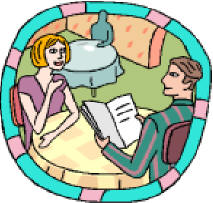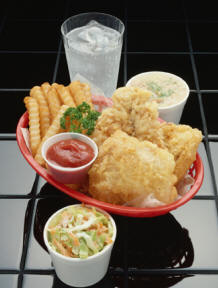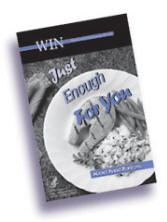Going Out to Eat


Going out to eat has its blessings and its challenges. What are some of the challenges?
-
Portions are huge in restaurants.
-
High-fat, high-salt, and high-sugar ingredients are frequently used. Since you don't do the cooking, you may not know what's in it.
-
Normally limited amounts of fresh fruits and vegetables are available. Even though you find salads, many of them are high in calories and fat due to the mayonnaise dressings (100 calories/tablespoon), shredded cheeses (at 110 calories and 8 grams of fat per 1/4 cup serving), crumbled bacon (33 calories/slice), olives (10 calories each), avocado (185 calories/ 1/2 cup), nuts or sunflower seeds (52 calories/tablespoon). You also may find yourself selecting a beautiful all-veggie salad and then adding a ladle of salad dressing, which is 1/3 cup, or 5 tablespoons, at about 65 calories/tablespoon, or 325 calories!
-
A "special occasion" mindset leads to ordering more appetizers, alcohol, and desserts.
So what are some helpful skills to develop and strategies to practice?
-
Most Americans are eating out at least 50% of the time. Monitor the frequency of how often you eat out. It makes a big difference whether you dine out once a month, or 3 - 4 times every week. How often do you go out to eat? If you do go out frequently, why? What contributes to that pattern? Do you find dining out regularly is an obstacle to your achieving a healthier weight? If so, what might you do to change that pattern? Perhaps review the making quick and healthy meals at home section for ideas about making delicious quick meals.
-
Choose the restaurant carefully. Select one that provides some healthful alternatives. Are you familiar with places that offer diverse, healthier choices?
-
Read over the menu and make wise menu selections. Do you know which menu words and descriptions telegraph higher fat and calories? Do you know how to find healthier options? If not, perhaps check out the online resources or books below.
-
Make special requests for what you really want and how you want it prepared. How skilled are you at asking for what you want?
-
Practice portion control. Restaurant portions have doubled from a few years ago. 70% of diners say that they will eat all that's placed in front of them when they eat out. So, how can you manage restaurant portions? check out--Keep an Eye on Portion Size. What is the difference between Portions and Servings? Serving Size Card: Serving Size Card.pdf
-
Begin by getting a mental picture of sensible portion sizes rather than the mammoth portions you are served. Check over the Foundation Food Plan section for reference portion amounts.
-
Perhaps use a doggie bag, share a portion with a friend, or just order soup and a salad, or order from the child or senior menu.
-
Another helpful idea is to drink water as you order and while you wait for your meal to arrive. Have you ever found yourself eating the chips and salsa, or all of the delicious, hot bread and butter that was offered, only to find yourself full before the food actually arrived? Remember: Jumbo meals = Jumbo bodies!
-
Don't be in a hurry to order dessert. Choose fresh fruit or decaffeinated cappuccino or herbal tea for a sweet finish for your meal, or wait until you go home and have a healthier snack at that time.
-
Other helpful tips:
-
Develop a healthy mindset. Watch out for thoughts like, "Oh, I'll just eat whatever and eat until I'm stuffed. I want to get my money's worth. I'm paying for it." Beware of being a member of the "clean the plate club."
-
Utilizing pre-planning can really help out. Perhaps cut back from having some extra portions during the day, or eat foods that are lower in fat and sugar, and eat extra amounts of vegetables and fruits that day to help conserve some calories. Many people find that having a small snack (veggie, fruit, or some water) prevents them from getting over hungry, especially if the selected meal time is later than your usual routine. How about for you? What strategies might work?
-
Modify your eating behaviors. Eat more slowly and with great awareness. Enjoy the foods you've selected. It takes 20 minutes for your stomach to notify your brain that you are full! Pause and talk to people, go to the bathroom, put your fork down, take sips of water (that slows your pace and helps your stomach feel full).
-
Redefine fullness. Tune in to body signals of satisfaction and fullness. Don't wait for a stuffed feeling. Stop when you're just satisfied. It's not your last meal. You will be able to eat again! Don't use the "empty plate" as your signal that you've eaten enough.
-
Enjoy the non-food pleasantries. Let yourself enjoy a few minutes of relaxation. Concentrate on the good conversation that you are having with friends. Look around and enjoy the environment. Take time to enjoy being waited on. And lastly, enjoy the fact that you don't have any dishes to do or messes to clean up!
-
One way to naturally balance for additional calories eaten is to plan some enjoyable physical activity into your routine afterwards.
What can you do? How do you cut back on fat and calories? How do you make special requests? How do you go to ethnic restaurants and make healthy choices?
Here are some suggested solutions from the Web:
Tips for eating out from Choose My Plate: http://www.choosemyplate.gov/weight-management-calories/weight-management/better-choices/eating-out.html
About food portions--Just Enough For You from the Weight Information Network. Check out their PUBLICATIONS page.
|
||||||
The WIN site has many other topics on weight control: http://arthritis.about.com/gi/dynamic/offsite.htm?zi=1/XJ&sdn=arthritis&zu=http://win.niddk.nih.gov/index.htm
Tips from the American Heart Association which include ethnic ideas and checklists for eating out: http://www.heart.org/HEARTORG/GettingHealthy/NutritionCenter/DiningOut/Dining-Out_UCM_304183_SubHomePage.jsp
Fast food nutrition – is it possible? Go to explore: http://www.helpguide.org/life/fast_food_nutrition.htm
Tips from Nebraska Lincoln--let the Pyramid guide your food choices: http://ianrpubs.unl.edu/foods/nf499.htm
Tips for dining out and getting less salt (for hypertension)--Includes ethnic food types: http://www8.utsouthwestern.edu/utsw/cda/dept100467/files/102009.html
Tips for following a lowfat lifestyle: http://www.lowfatlifestyle.com/diningout.htm
Tips for eating out with kids: http://www.hotelfun4kids.com/parenttravel/eatingoutwithkids.htm
Senior citizens' guide to eating-out tips for eating healthfully: http://www.seniorcitizensguide.com/articles/health/eatingtips.htm
Books on Dining Out
Guide to Healthy Restaurant Eating. By Hop S. Warshaw, MMSc, RD, CDE, McGraw-Hill Publishers, 2002.
|
Dining Lean. By Joanne V. Licten, RD, Nutrifit Publishing, 2000.
|
A fun book to review for calorie and fat content in VISUAL portions is:
Howard
Shapiro's Picture
Perfect Weight Loss: The Visual Program for Permanent Weight Loss
Filled with practical advice for lasting weight loss. The AMAZING FEATURE about
this book is that it has hundreds of comparisons (PICTURES) among foods
showing portion sizes and the calories that each contains. You will be surprised!
He also shows many ways to experience guilt-free dining out. Published by
Warner Books (paperback) in January, 2003. He also has a SHOPPERS GUIDE
for the supermarket to promote grocery store choices for permanent weight loss. Visit also: http://pictureperfectweightloss.com/
Restaurant and Fast Food Nutrition Facts
Check out Fast-Food and Chain Restaurant Nutrition Facts from Diet Power: http://www.dietpower.com/restaurants.htm
Fast Food Explorer: http://www.fatcalories.com/


